Greatest temples built by the kings of Egypt, still the rest of it from view stands witness to the creations of Egyptian civilization; considered Karnak Temple as a historical record is full of history and culture of Egypt from the Middle Kingdom until the rule of the Ptolemies of Egypt. Has the kings constructed chapels and gates on the campus of Karnak and the In keeping with their usual policy to appease the gods and priests of Egypt. effects of Karnak give us a clear picture of the history of Egypt in the renaissance for a period of up to two thousand years starting from the Middle Kingdom.
The temples of Karnak of the biggest and greatest Maced of buildings huge devoted to the worship of the gods in the history of the whole world. That study these temples detailed study integrated not considerin easy but are highly complex and perhaps why this is the disappearance of many parts of the temples and the demolition of other parts; but and use the foundations for new buildings. There is no doubt that the edifices ten Temple of Amun-Ra at Karnak was filled with still large numbers of pieces of stone used Khacoa her and taken most likely from other buildings and our guide on this is what was found cryptographic inside edifice third set up by Amenhotep III Temple of Amun-Ra at Karnak was found inside the following: -
1 - stones full cabin King Senusret I, which was built somewhere in the temple of white stone has been able to engineer archaeological cryptographic resides temple (Booth - Kosag - compartment) small and is now located in the area known idiomatically museum north of the temple courtyard.
2 - pink granite base name Amenemhat III and Amenemhat IV.
3 - the remnants of the inscriptions on the calcareous stones back to the reign of King Ahmose and Queen Ahmose Nefertari.
4 - the remnants of the stone panel from the reign of King Ahmose.
5 - Break cabin a Bible Alolabestr compound private King Amenhotep I, a place now Karnak.
6 - leftover traces of limestone inscribed with the name first Amenhoteb.
7 - the remnants of stones to the entrance of the limestone due to the reign of Thutmose II.
8 - lintel of sandstone dating to the reign of Thutmose II.
9 - blocks of red quartz stone cabin break the sacred compound due to the reign of Hatshepsut.
10 - remnants of limestone blocks to the entrance of the reign of Hatshepsut.
11 - remnants of cabin break the sacred compound of alabaster and was attributed to the reign of Thutmose III.
12 - a block of red granite representing Amenhotep II thrown arc arrows from his hands.
13 - the remains of the roof of alabaster dating back to the reign of Amenhotep II.
14 - base compound of alabaster dating back to the reign of Thutmose IV.
15 - the remnants of a column of sandstone and due to the reign of Thutmose IV.
16 - remnants of limestone blocks to the entrance in the reign of Amenhotep III himself constructed edifice third.
They also found the Egyptian mission French are restored Karnak when restoration of said ninth built by King Horemheb large numbers of stones known as Atalatat which had used Khaco of said ninth and that was basically part of the temple Amenhotep IV (Akhenaten) in Karnak. In fact, it was the land of Karnak holy include beside the great temple of the god Amun-Ra several temples to different gods, among them what is in the south, such as the Temple of Khonsu Temple gods ABT including Maeugd in the north such as the Temple of Ptah, including Maeugd in the Middle then demolished such as the Temple furnace. This means that the land of Karnak holy were not solely dedicated to the god Amun-Ra, but was also to other gods as explained have been informed of all these temples and chapels wall large brick up thick 12 meters and length to 550 meters and width to 480 meters and a height of 20 meters. It has an area of over sixty acres and has eight entries in the north arrive temples of Amun-Ra temple Montu is completely free of inscriptions; and two entrances in the southeast of them where there edifice X arrive temple gods of death and west of where the Temple of Khonsu and gate Ptolemy III (Iorgtis first) connects to Luxor Temple and two entrances in the east and three entrances in the West. East entrance where the first pylon, which is the main entrance of the temple.
Was Amenhotep I Kings Eighteenth Dynasty is the first thought in the construction of the temple of the god Amun-Ra at Karnak have chosen the same spot sacred was the ancient temple, which is due to the State Central took Thutmose I after the death of Amenhotep I undertook the establishment of the temple in the same sacred area or around sued yard dilapidated now to the northwest of the State Building Central then held the west of it said is known Pei edifice fifth and then set up in front of the east hall of columns Ozoria then constructed said another west is known Pei edifice fourth and stayed in front Mslten of red granite South still their list so far and reaches a height of 19,20 meters.
And get to the reign of Thutmose III, who lived some chapels in the yard of Tuthmosis I and took Mselty Hatshepsut buildings until the roof lounge with masters so obvious Mascl on Almslten of work then added central pillars new one west is known Pei edifice sixth, the youngest edifices all and the second south is known Pei edifice VII also built halls of the Annals behind edifice VI Hall Bank distinguishes two columns of pink granite stone, one representing the north and has a lotus flower symbolizes King also added at the eastern end of the temple hall "growth Brother" which is dubbed termed "a celebration."
Then came Amenhotep III adding the said is known Pei edifice third is ruined now has talked about what he found inside of the effects used Khaco him as also believed that Amenhotep III is the one who set up Wasfy masters huge brokered now has a masters (and compare them Bactin corridor Great Temple of Luxor) and private The rules of this masters do not have Stones Atalatat a Stones Temple furnace built by Akhenaten found in some rules tycoons other constructed thereafter as is also possible that Amenhotep III is the one who started the establishment by rams front Wasfy masters hosted by. then occurred tremor major and violent struggle between priests of the god Amun and the King Amenhotep IV (Akhenaten), who took the Aten Lord has sued his temples East Temple of Amun. remained conflict and struggle continues even came Horemheb, who was forced to appeased priests of Amun stood some repairs in the temple and built a new edifice west is known Pei edifice The second also added two other central pillars ninth and tenth in the south. this, we find that in order to satisfy the priests of Amon ordered the demolition of the temple furnace built by Akhenaten and taken from the stones tautology Sroha hosted by three.
Began Ramses first in the Nineteenth Dynasty constructed a masters did not witness history Egyptian architecture largest and most luxurious of them, a hall, which is located between Abhan third and second, but died and passed it was unable to be this huge project. Arose City first after the bulk of this work sued all masters of the East Wing and most of the masters of the southern wing and then came Ramses II complete the lounge and scored himself text and image.
I think City second of the kings of the Nineteenth Dynasty and later Ramses III of the kings of the Twentieth Dynasty that Temple of Amun-Ra had finished planning and this stayed Siti second three small chapels to the Theban Triad which built on the left inside the large courtyard after the first pylon directly as established Ramses III in the same small temple courtyard on the right of the entrance, a small temple, which is an excellent model to model the temples of the gods in the modern state.
Leave the Temple of Amun Ra without additions until the twenty-second family, a Libyan known to the family, building sea row captains of the huge open second front edifice. When Taharqa came one of the kings of the Twenty-fifth Dynasty established a corridor from the masters of the center of the courtyard did not keep him now is Aloston known his name.
Finally two Nkhtnpo established the first one of the kings of the thirty largest family Sorouh Karnak which is currently in the western facade of the Great Temple. The kings of the Ptolemaic Petrmemat in the temple and established Philip Aredeos (from 323 to 305 BC. M. a half-brother of Axanderalokpr) compartment of rose granite of the compound sacred inside compartment sanctum also set up also in the southern region in front of the Temple of Khonsu gate known as gate Ioarjtis a King Ptolemy III ( who ruled from 247_222 BC.).
Karnak Temple names:
Egyptians fired at the Temple of Karnak from the reign of Senusret I at least the name of "Father flattened." He stated this name on his cabin white campus interview Karnak and "Father may mean flattened spot selected for the thrones of the gods." In fact, this label is limited to only a portion of the temple which is which extends from the fourth edifice even a "brother growth", a sacred area since the beginning of the eighteenth dynasty until the reign of Amenhotep IV. The name, which was called the Temple of Karnak before the reign of Senusret I was most probably "the righteousness of Amun" Any home Amon has been mentioned on the board dating back to before reign Antv II of the kings of the Eleventh Dynasty. Either in the reign of Ptolemy of Egypt has called on the Temple of Karnak name "bit is free sa ta" Any sky above the earth.
Opinions differed on the Arabic name of the temple which is Karnak; sees some that word Karnak Arab are not used in level but is still used in Sudan and means "village fortified" has this applies to the Temple of Karnak is apparently the headmaster Surat huge "village fortified" .... and some see the word Karnak came from the word "Khurnq" (a place in Iraq near Najaf was Nu'man bin Almnzer had built a palace) and spent the floor later in scientists wrote Europeans to "crank" ... and there saw Dr. Ahmed Fakhry see the name Karnak is due to the name of the village near the temple and known by the same name.
Temple row
Begins temple Marsa work specially for the god Amun and he used when he was out of the temple at Karnak to visit the Temple of Luxor or harem South and on the occasion of the celebration of "Opet" and was sailing from the marina year front of the temple in a vehicle sacred "Auserhat" made from cedar wood restaurant gold in procession huge between Apthlat people even up to the Temple of Luxor
Rams Road
A path between two rows of statues consists of two top ram and body of a lion and a length of 52 meters and width 13.1 meters and away from the edifice first distance 20 meters and it was called in ancient Egyptian "Ta dead mortgaged" Any way rams was the ancient Egyptian believed rams protect Temple and intervention have formed sculptures in the form of rams because the ram was considered a manifestation of the god Amun-Ra which is placed on a high base under the header of each ram royal statue on the grounds that the god Amun in the form of a ram protect the king. The rams originally named Ramses II, which are carved in his then record Bangm'm Bankhy one Dynasty XXI his name on some of these statues. Likely that this route was extended until edifice second evidence the presence of residual statues rams this in a long row on both sides of the poles large patio open immediately after the first edifice.
Now we come to the first pylon and a length of 113 meters and a height of 40 meters and a thickness of 15 meters which is due to the reign of King Nkhtnpo first of the kings of the Thirtieth Dynasty has not been built yet and possible ascent to the surface of the edifice of peace in the north tower and features edifice first be the western facade of the temple there slopes mud, which was used to transport the stones of the building was removed these cliffs in the North Tower, and in the western side of the south tower has been left Antiquities Authority slope is located on the eastern side of the South Tower is like clear mud slopes.
There on the northern interior of the edifice first direct Thelah booths built King City the second Theban Triad Bible which is about a small building of sandstone with three chapels: Central dedicated to Break composite Amun Ra and left to break a composite of death and the right to break composite Khonsu in accordance with the views on the interior walls each compartment. The King City launched a second chapels "great temple of millions of years" primarily front of Alapt pagoda Sot.
Temple of Ramses III:
I think Ramses III that Temple of Amun-Ra had finished planning the establishment edifice second and by rams him especially that City II had risen from the earlier construction Mqasirh three of the Trinity Bible on the left "in front of the Temple of ABT Sot" preferred to Ramses III that resides temple south (to the right inside) in front of the Temple of ABT also flattened. The establishment of "a great place sacred holy ground front ABT Sot". Did not know that his temple he was destined to be integrated in successive additions of the Great Temple yet he is composing alone architectural and clear.The Temple of Ramses III living model of the temples of God in the modern state and was dedicated also rested boats holy trinity good reign of Ramses III begins Besrah injury a lot of vandalism see attic corresponding traditional mostly Matujd the edifices king photographer and his companion (Ka) slaughtered captives a mask they feel in front of Amun who offer him three rows of cities seized each of which represents people protrudes from the cartridge inside City seized. Advanced edifice statues of Ramses III and carved from sandstone.
We are now entering into a courtyard, exposed side rows of sixteen columns eight on each side stood in front of each column statue of the king in his image Alawsir has hit distortion mostly represent scenes on the back wall of said King in his Bamon which gives him the "love six" which may indicate that the king's promise by virtue of long either on the eastern wall there represents the views of the procession of the Holy Trinity, where the king advanced priests who hold sacred boats of Amun, death and Khonsu. Either on the west wall there is a view represents a procession deity Maine Lord fertility where King sprayed on the statue of the god incense Maine - Amon Mobile by priests get to the southern wall of the courtyard open by upward Ahdor. And make this the recipe depends ceiling wall on four columns Atguetdamha statues king's Aozyreh. The views of this wall King in his various gods and goddesses, especially Theban Triad Behind this wall, we find a cross-sectional; Download ceiling on four masters of Papyrus crowns sprouts can be considered to lobby lobby masters. The blade of the entrance in the wall south to Bhoasatin depends roof on eight masters in two rows with capitals in the form of buds. Represent views lobby masters corresponding traditional representing King in the presence of the gods and goddesses is based cleansing and launch incense and sacrifice as well as religious rituals Mokhtvlh.
Finally we get to shrines holy of holies three Central private boat of Amun and the right private boat Khonsu and convenience private boat gods of death and in accordance with the views recorded on the walls of the Interior of the chapels in addition to some cabins profiles supplies offer ritual as a next compartment death chamber by him connects to the surface of the temple.
The length of this temple 52 meters and extends its axis from north to south along the eastern wall of the Temple of Ramses III There is a small lounge known hall Albobstian and lead by Asitonin be the entrance known entrance Chacang. Landscapes here are King Chacang and Tklot first daughter Osorkon of the kings of the twenty-second family in the presence of different deities.
We go now to the center of great patio open, we find Aston Taharqa famous one Dynasty twenty-fifth, a residue hall masters huge has constructed this king Ethiopian in the seventh century BC has interest effects in both 1928.1929 rebuild this Alaston discovered the names of each of the Psammetik second of the kings of the family twenty-sixth and Ptolemy IV, known as Velomattur the Stones this Alaston papyrus which height of up to 21 meters and has a crown-shaped flower papyrus ripe This was Hall consists of two rows of tycoons on the base in the middle of the compound holy to God Amun during the celebrations.
Get edifice second or to the remains edifice second is a dilapidated largely has begun construction of King Horemheb and completed Ramses first and scored his name Ramses II and added him additions from the era Iorgtis second which Ptolemy VIII was long, 98 meters and Ratfall 29.5 meters and thickness 14 has found in 1954 near him on a huge statue of the king Bangm'm Bankhy of the kings of the family first and twenty-There is a belief that the king Bangm had robbed of King Ramses II and especially since the statuette standing over his feet as soon as possible to statues Nefertari wife of Ramses II and the statue shrine now to the left of home the second said. was second ahead edifice eaves (or ceiling) dating back to the reign of King Taharqa and renewed Psammetik second.
Now we come to the lobby of the masters of the great, the biggest lobby ever masters built in the world and most luxurious Maced of buildings for the purpose of religious and length 52 meters and width 103 meters and holds its roof 134 Aston constructed of sandstone and has sixteen description is believed that King Amenhotep III is the one who set up Almmrien key and include twelve Astona cylindrical leg at the bottom and on the shape of a flower crown Barada ripe and has chickened Aston (without Arkisah 19.25 meters) and a diameter of up to three meters and surrounding more than ten meters. And established Seti I rest الاساطين and the 122 Astona The 14 description seven rows on each side and a high Alaston 14.74 meters and took their crowns form buds papyrus and thus ceiling lobby on two levels so above the waist roof side and took advantage of the difference between the roof Ugah three overhead Ugah side work windows luxurious stone allow the leaking light to illuminate the way to the lobby, a god procession route.
Fired City first on this gym name "Temple of God (Job) City lovable Petah useful in the Temple of Amun" and looks like work in inscriptions this hall and scenery did not end in the reign of Seti I Vokmlh King Ramses II Noting that views and inscriptions northern half of this hall belongs mostly King Seti I either views and inscriptions of the southern half of this hall is attributable to the reign of Ramses II. He also added some of the kings like Ramses III, IV, VI and King behooves Hur names on masters and the walls of this hall.
Indicate remnants colors on the crowns of masters and ceiling to views this hall and carvings were decorated with color cost and beautiful landscapes which on the north wall and of King Seti I and posed It does perform religious rituals of different and perhaps the most important theorist who represents King City kneeling under the sacred tree and the machine Thoth writes his name on the leaves. On the same wall, but from the outside, we find views of Seti I in a fight with Asians and victory for them either corresponding internal on the south wall of the lobby of the masters represent King Ramses II in his relations with different gods and goddesses and perhaps thus find view theorist who represents Ramses II in the dress priests the firing incense in front of the convoy Amon holy carried by priests who are wearing masks all of the souls of Bhutto (heads hawks) and lives نخن (heads jackals) and then followed on the shoulders of the priests also both composite Khonsu and composite death either landscape Foreign this wall represents wars Ramses II in Syria and on the same south wall but from the outside there is a prominent Wall engraved with the poetic text of the Battle of Kadesh, which is commonly known as hair "Bntaúr" referring to the name of the author who organized. The record Ramses II named on each of the two entrances north and south of the lobby masters fired at the southern entrance name "door great king Upper and Lower Egypt and walk Maat Ra step that Ra son Ra Ramses II loved Amon (named) a great impact in the Temple of Amun" ... and fired on the northern entrance the name "the great door of the King of Upper and Lower Egypt Mr. Maat earths, and the secret of Ra step Ra Ra Ramses loved Amon (named) Shining in the house of Amun."We get to the third edifice building this and Maitbah edifice edifices like the fourth, fifth and sixth .. etc.. Has its own difficulty Perhaps the reason is the succession of kings and even Hedmam Macedh predecessors of the kings and their new structure the groves of concern to them, and then after that comes the role they can recite them Maamloh those who preceded them and so on. For example third edifice, built and is built by Amenhotep III is no doubt that ordered the demolition of all buildings used by Khaco him from previous eras of his reign has been mentioned by detail .... It is hard now to imagine the human beauty of this edifice, which was representing the western facade of the temple in the custody of the reason that he ruined largely But we can through text left by King Amenhotep III on the plate was found in the temple perpetuate his memory mainland western Taiba know full description of this edifice (painting now in the Egyptian Museum has raped Merneptah) and the inscription on the back is "Gate (entrance) is so great in front of Amon Ra Syed thrones earths plated surface all gold and the image of God in the form of a ram studded Balosud real and inlaid with gold and precious stones are numerous and not unprecedented and land adorned with silver and up edifice of the sky like poles sky four and shimmering poles informed of armored gold more than Heaven. "
A dilapidated edifice third now have talked about what he found inside the effects and has been used his Khaco and perhaps delusional: stones full cabin Senusret I white marble stones to the first compartment Amenhotep stones and special rest stop boat Scripture of Queen Hatshepsut and idiomatically known red cabin.
Out now from the northern entrance to the large courtyard to get to the museum aspiring idiomatically Vnchahd on the left (west) compartment Hatshepsut Stones and most scenic represent relationship Queen gods and the gods. Then we get into the first compartment Senusret.
Josk Jubilee King Senusret first:
Found stones full this Jawsk within effects found by the third within the edifice built by King Amenhotep III of the kings of the eighteenth dynasty in the temples of Karnak. He has re-built by the French architect cryptographic 1936 He now serves in the area known as the "museum" on the North home after the first edifice of the temple.And Jawsk a white limestone good words of a small base is relatively high held above Hall characterized Busbandtin on one axis and characterized each interface existence drawer simple mediates Ahdor arrive to the entrance and features each drawer there was a "balustrades" a summit roundabout as that each interface featuring four columns mediates entrance the second and third columns The other two sides of the temple of Vićabhan into their system with system interface is much longer they and not their entrance. And distinguishes the same reproach Alawi entrance adorned with winged sun and above watch Egyptian Corniche, which surrounds Supreme fingertips temple.
Mediates the temple hall square of granite flanked by four columns divided into two rows and the corresponding notes and texts that are inscribed on the walls and columns of this temple has reached the end of the magnificence and perfection demonstrated the ability of Egyptian artist in that era. Almnazeragelbha represents King with different relationships with the gods. Either texts, perhaps delusional Maivkr different regions of Egypt in this period and its Link remote dam of King Senusret I have disagreed consensus target of this temple. Cryptographic believed that the temple was the temple compound Bible Break your god Amun-Ra, who was his statue is placed inside the holy shrine during religious ceremonies and believes that Aldel this is the rule and the presence of granite the doorways Alsaaadan the temple.
First compartment Amenhotep:
Next to the first compartment Senusret (north), we find another small cabin and marble stones are all found within the third edifice was rebuilt in this place which compartment Amenhotep I have added to their carvings King Tuthmosis I which is a rectangular hall opens from both sides emblazoned abroad Egyptian Corniche.Represent the corresponding external wall of northern Amenhotep first in his various religious with the god Amun Fenrah offerings as well as view weather known as "streaming" "Fried" sense "either corresponding external on the south wall represents Tuthmosis I in his Religious with Amon We note here also weather known "by running Baldvh and paddle" and the private view to set up limited "Preheat"
The entire interior views represent Amenhotep first in different religious views in front of Amun-Ra. Was launched on this cabin in ancient Egyptian name "until scattering of Amun growth" temple effect immortal words of Amun.
Then back again to the large courtyard open to supplement visit the Temple of Amun-Ra.
Leila edifice third courtyard where King stayed browser Thutmose the first Mslten and two Almseltan which were Mqamtan front edifice fourth who was most likely represents the entrance of the temple in his reign. As established Thutmose III then Mslten in the same yard did not keep four of these obelisks is only one place, the temple of Karnak and the remainder was transferred out of the country. The obelisk remaining belong to the king Tuthmosis I and reaches a height to 21.3 meters and weighing up to 143 tons and the three rows vertical texts belongs East them to the owner of the obelisk Tuthmosis I then added King Ramses IV grades Ganbean. And there views represent Ramses II on the base. We also note that the south wall after the third edifice and entrance was added in the reign of Ramses IX.
When I took Hatshepsut reins of government ordered the establishment Mslten in this hall under review and likely as a result it still masters of wood and stripped the bulk of the ceiling. Still so far obelisk left them a list in place and a height of 29.50 meters, a stone rose granite and weighing up to 323 tons and built on a square base; along the rib 2,65 meters. has registered on the base of the obelisk story these Almslten which commanded Bchiedahma time which was cutting them off and the reason for which it was Aqamta. We do not know for now the reasons for Hatshepsut to establish these Almslten in this hall is precisely that it has been achieved where prophecy coronation enemy Thutmose III was launched on this hall more than a name in the ancient Egyptian language and all synonyms for one meaning is "a masters papyrus" has dubbed in Prince Tuthmosis I name "Aont chipset or the Lago" meaning "a masters great papyrus" During the reign of Hatshepsut, known as "The Ajit chipset" interchangeably .. and when it came Thutmose III, who was hated Hatshepsut harshly work to conceal these Almslten by establishing the walls around them did not remain two only Nhithma. In this way the campus of Hatshepsut at least in his glory which was Cetktsabh of establishing these Almslten.
Now we come to the remains edifice fifth demolished was the establishment of Tuthmosis I also fired on the entrance the name "Amun and Rhevc" meaning "Amun great grandeur" and from him to a masters hosted by Tuthmosis I also called "Aont chipset" meaning "hall great" and was Asatinha with six ten ribs in addition to the side Aloozyreh columns and added Thutmose III two small rooms on both sides of the entrance fifth Albh.
Then we get to the remnants edifice sixth small built Thutmose III of the sandstone and so-called "great edifice Homeland" and called on the entrance made of granite stone name "gate great (unnamed) of news Ra (name coronation of King Thutmose III) loved Amon senior greatness or position. " They have established Thutmose III lounges yearbooks after edifice sixth directly find on both sides of the hall first courtyards north and south by the remnants of chapels hosted by Amenhotep first and renewed Thutmose III. Characterized Hall first existence two Acamanm Thutmose III rose granite adorns the north including flower papyrus symbol Delta and adorns the southern two lotus flower symbol level. There in the lounge first also statues to the left inside, one representing the god Amun and the other representing the gods Lamont has ordered her stay Tutankhamun of sandstone and this is noted similarities great between them and the features of Tutankhamun famous was raped Horemheb statues and Nsabhma for himself.
After that we get to yearbooks second lounge and John Wilson believes that the selection of Thutmose III to this particular place "is proving that King had filed the performance ماعلية right about the god Amun was a partner of the king, but the most important partner." There were limited Holy of Holies, which was brought by Thutmose III will most likely center yearbooks second, after the removal of Thutmose III cabin that existed from the reign of Hatshepsut and set up by having removed most likely compartment was his place in the era of the Middle Kingdom. Has been described Egyptian texts compartment Holy of Holies, which hosted by Thutmose III as follows:
"His Majesty has held sacred compartment in granulated Amon place (called) the Great Throne, which approved the sky like (and manufactured) from Red Mountain stone sand and gold was inside a restaurant." Featuring two showrooms Annals of Thutmose III five entrances entrance edifice itself the first two entries in the lounge north and south and three in the second hall in the north and east. The cabins, which on both sides of the hall yearbooks second often stay due to the reign of Thutmose III; except compartment one important set up Hatshepsut and can be accessed from the northern entrance made of granite stone lions found in the lounge Second Annals in order to see McCann out of beautiful still some retains Ballowanh then see cruelty revenge as ordered Thutmose III to remove all forms of Hatshepsut from this room. Established Philip Aredeos compartment Holy of Holies current is made of granite stone pink and allocated to the compound sacred god Amun is still out for because the rule which was sealed with a boat of Amun Bible and potentially Philip Aredeos had ordered the construction of this cabin somewhere compartment old dating back to the era of Thutmose III and cabin Philip Aredeos words of two rooms rectangular length of the first 6 meters and the second 8 meters has covered the walls of this cabin interior and exterior views of religious, mainly landscapes on the south wall (right) and it views represent the culmination of the king and the submission of the machine and then parade composite Amon Bible. still landscapes retain colors. Then we get to the large patio is not only some stones a place which is believed that the temple which dates back to the era of the Middle Kingdom was praising it.
Temple lobby celebrations:
We find at the end of a courtyard of the Middle Temple hall celebrations held by the Tuthmosis III in the fourth year or the twenty-fifth of his reign after the death of Hatshepsut and likely he celebrated far "dam first" or "Jubilee first" has been dubbed "brother growth" meaning "beneficial impact or Shining "and that he meant here timeless buildings bright or useful. The temple includes three basic parts are as follows:1 - closets southern and northern side and was intended to save the temple supplies of food and drink and perfumes, clothing and decades. Large lobby of the masters and columns called idiomatically lobby holidays.
2 - rooms in the Middle adorned the Holy of Holies and beside the north hall with four masters know idiomatically garden plants and so what adorns the walls of the corresponding expressions of plants, birds and animals brought Thutmose III from Syria in the twenty-fifth year of his reign to garden temple and this can be seen as Thutmose III first-founder of garden animal in the world. now and we will talk about the lobby of holidays:
Get him through the entrance located in the southwestern part;, a large rectangular length of 43.2 m long and 15.6 is unique in its layout and architectural style has tried to engineer the Egyptian royal tradition tent that was erected in the wars it seems huge Ksardaq of stone strikethrough two rows of masters high in each row ten masters of style which has been termed the Baston Khaimah may seem crown this Alaston upside down is like bell opened from the bottom and rounded at the above where settle attic substrate above reproach Perhaps the reason for this is that columns Khaimah wood must knock of Declaration not like the masters of plant that grows (adopted) from the bottom to the declaration. Was held in the aspects of this lobby four row of columns the 32 column, the lowest rise of masters in the center and thus equal ceiling on flat-faced two holes let the light and noticed that the rules masters were cut deliberately perhaps in order not to impede the course of the boat was found in the small room located in the southwestern corner stone on the list of the names of the kings who cared most likely Karnak was erected by Tuthmosis III there and for this you know the list of Karnak was transferred Press Daphne in 1844 to the Museum of savings, where he was now. The archaeological believes Heaney lobby celebrations Thutmose III represents in terms of the first phase of the engineering Bazlka has in the Temple of Ramesses and then found its way after so out of Egypt.
South Building of the Temple of Amun-Ra at Karnak:
Now go back to the yard East between Abhan third, fourth and it headed south to visit the southern part of the Temple of Amun-Ra, we find we have a yard devastating him fame, a patio, which precedes edifice seventh was the establishment of Thutmose III, was found when a dare in the period between 1902 and 1909 on a huge array of statues various (799 stone and 17000 of Bronzing mostly in the Cairo Museum now) There is no doubt that these statues were built sometime inside the temple, before asylum priests to hide in order to preserve it most probably before the Assyrian invasion and this is called the courtyard name "yard crypt." On the western wall of the courtyard we find views represent Ramses II in his relations with different gods and goddesses and on the same wall, but from the outside we see (from north to south) stock represents King Ramses II in his chariot warfare against Castle then King on his feet attacking the castle and chariots in wait after Therefore, we find the text of a treaty of peace held by Ramses II of the Hittites in the twenty-first year of his reign.Established Thutmose III edifice VII a vandal was recorded on my face edifice northern and southern landscapes traditional to suppress enemies we see King once a suppresses Asians and times which suppresses Nubians in front of the god Amun. Was launched Thutmose III at the entrance to this edifice made of granite called "door (entrance) ( Title) Thutmose III and Amun Ra Azimi Transfiguration. " Thutmose III have established also four different statues to him in front of the northern facade of the said two on each side as there is also a three statues from different eras is difficult to know the owners.
Tiger now from seventh edifice entrance to get to the courtyard in front of me to watch a southern facade of the edifice. We find the west front of statues of Ramses III and Tuthmosis III's east. We find in the yard, which precedes the eighth and advanced edifice edifice seventh on the left remains of a small building was dedicated to break the sacred compound due to the reign of Thutmose III.
Now we come to the edifice and an eighth, in the opinion of Bareign according to the views and inscriptions due to the subscription period in office between Thutmose III and Hatshepsut was first charted City after that.Views of the northern facade of this edifice is the religious views of Queen Hatshepsut and the number of kings who have contributed in the construction and renovation of this edifice likes of Thutmose III, II and Seti I and Ramses III which views appear of worship Almokhtvlh relations with gods and goddesses.





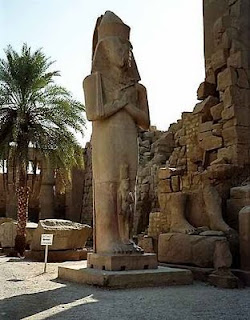
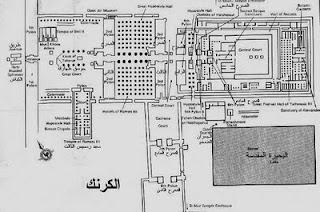

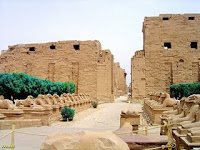
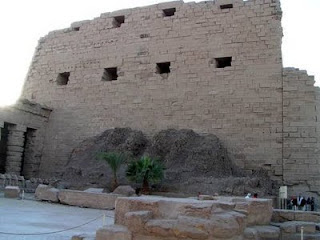
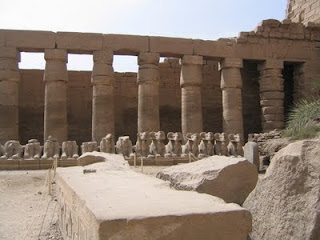
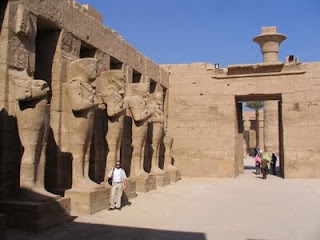
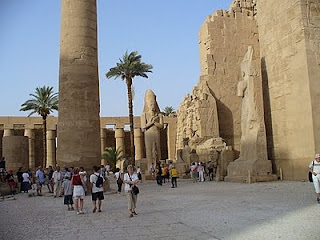

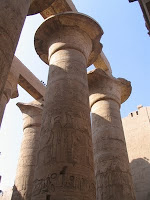

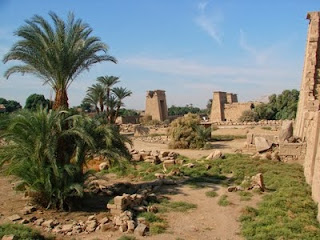


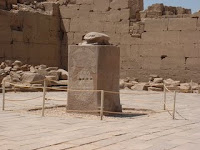
No comments:
Post a Comment